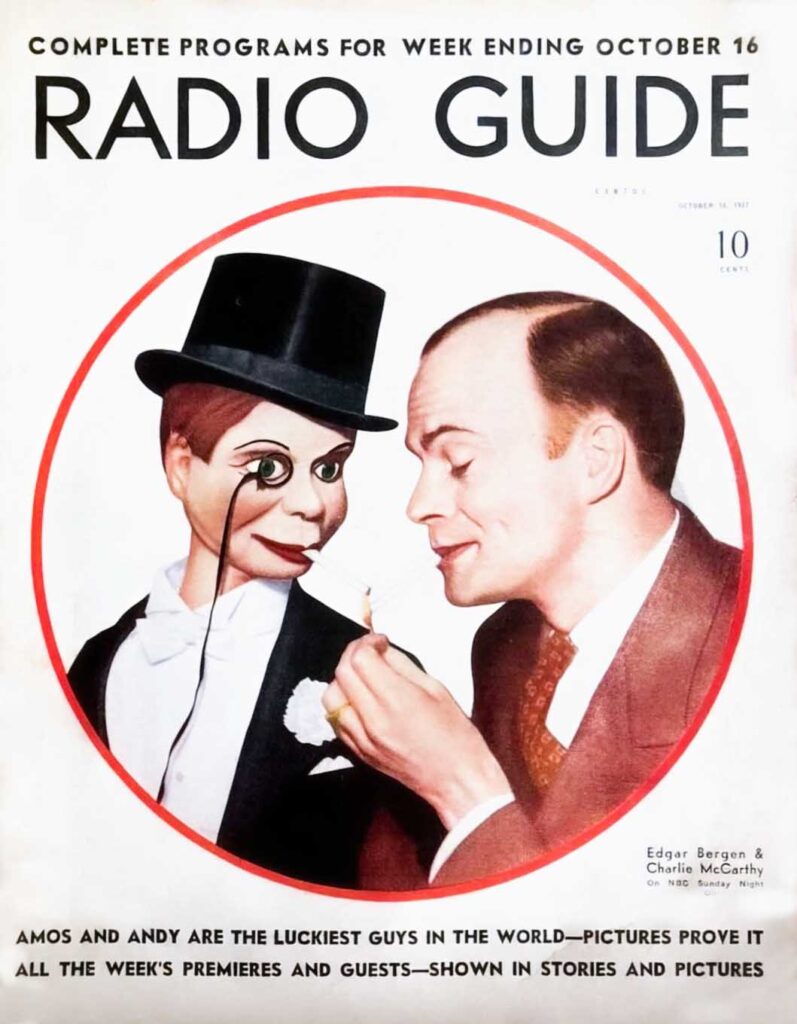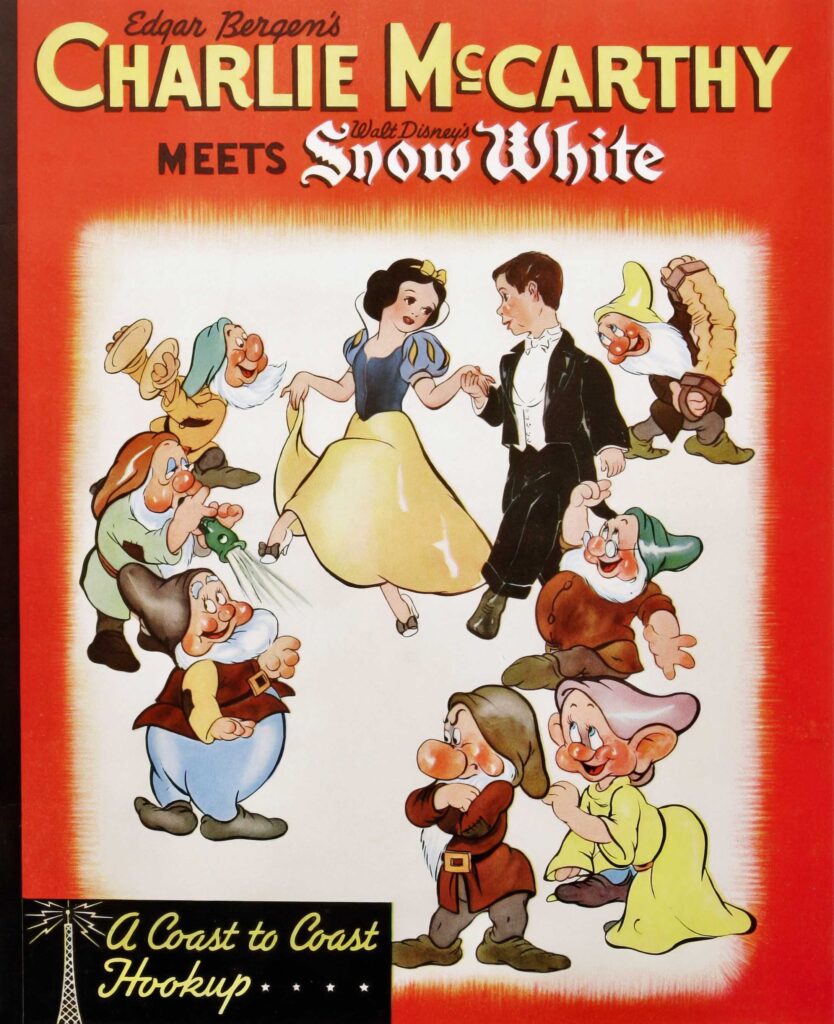Production information
Title of the Show: The Chase and Sanborn Hour
Sponsored by Chase and Sanborn
Orchestra leader: Robert Armbruster
Network: NBC
Episode: 33
Air date: December 19, 1937
Cast
Hosts: Don Ameche, Edgar Bergen, Charlie McCarthy
Snow White: Adriana Caselotti
Queen: Lucille La Verne
Slave in the magic mirror: Moroni Olsen
Doc: Roy Atwell
Sneezy: Billy Gilbert
Grumpy: Pinto Colvig
Singers: Rudy Vallee & Dorothy Lamour
Special guests: Billy Mauch, Claude Stroud, Clarence Stroud
Back to Radio Programs
Listen to the show
This is a condensed version with most non-Snow White or non-Charlie McCarthy bits edited out.

The Charlie McCarthy Show
The thirty-third episode of The Chase and Sanborn Hour, sponsored by Chase and Sanborn coffee, aired on NBC on December 19, 1937, and features songs by special guests Nelson Eddy and Dorothy Lamour, the Robert Armbruster orchestra and Billy Mauch from the Mauch twins (The Prince and the Pauper), “and through the courtesy of Walt Disney, the voices behind the screen characters of the first full length cartoon feature: Snow White and the Seven Dwarfs.”
The episode is presented by Don Ameche, but Edgar Bergen and his puppet Charlie McCarthy, a very popular comic duo of the time, steal the show. Their popularity cannot be overstated. The pair started on the radio on December 16, 1936 on Rudy Valle’s “The Royal Gelatin Hour”, and got their own show on May 9, 1937 thanks to Chase and Sanborn, and by the late forties, they had a TV show.
For Walt Disney, they made several promotional shows on the radio for Snow White, a Christmas TV show and of course, they starred in the partially animated feature: Fun and Fancy Free. In a series of famous photos of Walt holding production art from Snow White in his office, you can spot Charlie McCarthy in the background. The puppet even appeared in animated form in the cartoon Mother Goose Goes Hollywood. Also, Charlie McCarthy merchandise were often sold alongside Snow White toys at the time, such as the ventriloquist Dopey doll next to a Charlie doll, or glasses, or rubber balloons, and so on.
The previous episode of the Chase and Sanborn Hour, then the highest rated show of the year, aired on December 12. The sexy siren of the screen Mae West and Don Ameche played “Adam and Eve” and her sultry treatment of this biblical story caused quite a scandal. The following episode was much more family-friendly.
Introducing the cast of Snow White
The storyline of this radio program was published in an illustrated book published by Whitman Publishing Company : Edgar Bergen’s Charlie McCarthy Meets Walt Disney’s Snow White.
In the episode, Charlie reveals that he plans to trap Santa Claus on Christmas eve. He reads the letter he wrote him complaining of his previous presents. Hen then tries to scam his friends by selling them overpriced Christmas cards.
Then, the dwarfs are heard singing “Heigh Ho”: Edgar explains that Charlie will get to meet the dwarfs for the first time. Indeed, the premiere of the film is still two days away. The dwarfs then sing the sheet music lyrics of “Whistle While You Work” (as opposed to the film’s lyrics).
Charlie then meets each character individually. Its is both the occasion to introduce the characters to the audience, and to showcase every artist behind them. First Grumpy, voice by Pinto Colvig, then Sneezy who makes the audience laughs by sneezing through his speech with the voice of Billy Gilbert. Roy Atwell as Doc then stutters frantically.
It is almost incredible to hear a live audience laughing so hard at each artist’s antics, proving that Walt Disney made a wise choice in selecting them to voice his characters.
The Queen, who only appears in very serious scenes in the film, has a conversation with Charlie who keeps cracking jokes. She then addresses the magic mirror, who replies with the voice of Moroni Olsen that Snow White is the fairest in the land. As the Queen disappears, Snow White appears and speaks with the voice of Adriana Caselotti. As the word “apple” is pronounced, the Queen returns as an old witch and Lucille La Verne shifts her voice accordingly to propose a poisoned apple to the Princess. Charlie locks her up in a closet. Snow White is thankful and calls the puppet “my Prince”. Charlie then gets confused and starts mumbling like Doc and sneezing like Sneezy.
It is interesting that the dwarfs chosen to appear are those that have the most instantly recognizable traits. Even Sleepy, who could talk since Pinto Colvig is present, does not get a single line. And the soon-to-be-most-popular-but-mute dwarf Dopey is only fleetingly mentioned.
It is worth noting that all characters are voiced by the original artists heard in the film, and none of them are named on the program. However, in the case of Lucille La Verne, it may very well be one of her very last public appearance.

